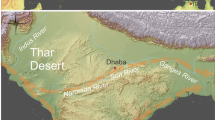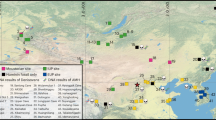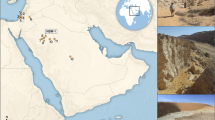Abstract
The Acheulian is one of the first defined prehistoric techno-complexes and is characterized by shaped bifacial stone tools1,2,3. It probably originated in Africa, spreading to Europe and Asia perhaps as early as ∼1 million years (Myr) ago4,5,6. The origin of the Acheulian is thought to have closely coincided with major changes in human brain evolution, allowing for further technological developments7,8. Nonetheless, the emergence of the Acheulian remains unclear because well-dated sites older than 1.4 Myr ago are scarce. Here we report on the lithic assemblage and geological context for the Kokiselei 4 archaeological site from the Nachukui formation (West Turkana, Kenya) that bears characteristic early Acheulian tools and pushes the first appearance datum for this stone-age technology back to 1.76 Myr ago. Moreover, co-occurrence of Oldowan and Acheulian artefacts at the Kokiselei site complex indicates that the two technologies are not mutually exclusive time-successive components of an evolving cultural lineage, and suggests that the Acheulian was either imported from another location yet to be identified or originated from Oldowan hominins at this vicinity. In either case, the Acheulian did not accompany the first human dispersal from Africa9,10 despite being available at the time. This may indicate that multiple groups of hominins distinguished by separate stone-tool-making behaviours and dispersal strategies coexisted in Africa at 1.76 Myr ago.
This is a preview of subscription content, access via your institution
Access options
Subscribe to this journal
Receive 51 print issues and online access
$199.00 per year
only $3.90 per issue
Buy this article
- Purchase on Springer Link
- Instant access to full article PDF
Prices may be subject to local taxes which are calculated during checkout
Similar content being viewed by others
References
Leakey, M. Olduvai Gorge: Excavations in Beds I & II 1960–1963 (Cambridge Univ. Press, 1971)
Isaac, G., Ll & Curtis, G. H. Age of early Acheulean industries from the Peninj Group, Tanzania. Nature 249, 624–627 (1974)
Asfaw, B. et al. The earliest Acheulean from Konso-Gardula. Nature 360, 732–735 (1992)
Goren-Inbar, N. et al. Pleistocene milestones on the out-of-Africa corridor at Gesher Benot Ya'aqov, Israel. Science 289, 944–947 (2000)
Scott, G. R. & Gibert, L. The oldest handaxes in Europe. Nature 461, 82–85 (2009)
Pappu, S. et al. Early Pleistocene presence of Acheulian hominins in south India. Science 331, 1596–1599 (2011)
Gowlett, J. A. J. in Stone Age Prehistory (eds Bailey, G. N. and Callow, O. ) 243–260 (Cambridge Univ. Press, 1986)
Klein, R. The Human Career: Human Biological and Cultural Origins 3rd edn (University Chicago Press, 2009)
Swisher, C. C., III, Curtis, G. H., Jacob, T., Getty, A. G. & Suprijo, A. Age of the earliest known hominids in Java, Indonesia. Science 263, 1118–1121 (1994)
Gabunia, L. et al. Earliest Pleistocene hominid cranial remains from Dmanisi, Republic of Georgia: taxonomy, geological setting, and age. Science 288, 1019–1025 (2000)
Harris, J. M., Brown, F. H. & Leakey, M. G. Geology and paleontology of Plio-Pleistocene localities west of Lake Turkana, Kenya. Contrib. Sci. 399, 1–128 (1988)
Roche, H. et al. Les sites archéologiques plio-pléistocènes de la formation de Nachukui, Ouest-Turkana, Kenya: bilan synthétique 1997–2001. C. R. Palevol 2, 663–673 (2003)
Harmand, S. Raw material and economic behaviours at Oldowan and Acheulean sites in the West Turkana region, Kenya. In Lithic Materials and Paleolithic Societies (eds Adams, B. & Blades, B. ). 3–14 (Wiley-Blackwell, 2009)
Feibel, C. S., Harris, J. M. & Brown, F. H. in Koobi Fora Research Project Vol. 3 The Fossil Ungulates: Geology, Fossil Artiodactyls, and Palaeoenvironments (ed. Harris, J. M. ) 321–370 (Clarendon, 1991)
McDougall, I. & Brown, F. H. Precise 40Ar/39Ar geochronology for the upper Koobi Fora Formation, Turkana Basin, northern Kenya. J. Geol. Soc. Lond. 163, 205–220 (2006)
McDougall, I. & Brown, F. H. Geochronology of the pre-KBS Tuff sequence, Omo Group, Turkana Basin. J. Geol. Soc. Lond. 165, 549–562 (2008)
Lourens, L., Hilgen, F., Shackleton, N. J., Laskar, J. & Wilson, D. in A Geologic Time Scale (eds Gradstein, F., Ogg, J. & Smith, A. ) 409–440 (Cambridge Univ. Press, 2004)
Kidane, T., Otofuji, Y.-I., Brown, F. H., Takemoto, K. & Eshete, G. Two normal paleomagnetic polarity intervals in the lower Matuyama Chron recorded in the Shungura Formation (Omo Valley, Southwest Ethiopia). Earth Planet. Sci. Lett. 262, 240–256 (2007)
Lepre, C. J. & Kent, D. V. New magnetostratigraphy for the Olduvai Subchron in the Koobi Fora Formation, northwest Kenya, with implications for early Homo. Earth Planet. Sci. Lett. 290, 362–374 (2010)
Ninkovich, D., Opdyke, N. D., Heezen, B. C. & Foster, J. H. Paleomagnetic stratigraphy, rates of deposition and tephrachronology in North Pacific deep-sea sediments. Earth Planet. Sci. Lett. 1, 476–492 (1966)
Clement, B. M. & Kent, D. V. Geomagnetic polarity transition records from five hydraulic piston core sites in the North Atlantic. Initial Rep. Deep Sea Drill. Proj. 94, 831–852 (1987)
Tauxe, L., Opdyke, N. D., Pasini, G. & Elmi, C. Age of the Plio-Pleistocene boundary in the Vrica section, southern Italy. Nature 304, 125–129 (1983)
Zijderveld, J. D. A., Hilgen, F. J., Langereis, C. G., Verhallen, P. J. J. M. & Zachariasse, W. J. Integrated magnetostratigraphy and biostratigraphy of the upper Pliocene–lower Pleistocene from the Monte Singa and Crotone areas in Calabria, Italy. Earth Planet. Sci. Lett. 107, 697–714 (1991)
Roberts, A. P., Florindo, F., Larrasoaña, J. C., O’Regan, M. A. & Zhao, X. Complex polarity pattern at the former Plio–Pleistocene global stratotype section at Vrica (Italy): Remagnetization by magnetic iron sulphides. Earth Planet. Sci. Lett. 292, 98–111 (2010)
Wood, B. A. Koobi Fora Research Project Vol. 4 Hominid Cranial Remains from Koobi Fora (Clarendon, Oxford, 1991)
Spoor, F. et al. Implications of new early Homo fossils from Ileret, east of Lake Turkana, Kenya. Nature 448, 688–691 (2007)
Kirschvink, J. L. The least-squares line and plane and the analysis of palaeomagnetic data. Geophys. J. R. Astron. Soc. 62, 699–718 (1980)
Zijderveld, J. D. A. A. C. in Methods in Paleomagnetism (eds Collinson, D. W., Creer, K. M. & Runcorn, S. K. ) 254–286 (Elsevier, 1967)
Acknowledgements
We thank the office of the President of Kenya and the National Museums of Kenya for permission to conduct this research, TOTAL Kenya for logistical support, and the WTAP team. Funding was provided by the French Ministry of Foreign Affairs and the National Science Foundation (BCS 02-18511 to C.S.F.). Lamont-Doherty Earth Observatory is acknowledged for ongoing support to the Paleomagnetics Laboratory.
Author information
Authors and Affiliations
Contributions
C.J.L. recorded field sedimentological and stratigraphic data, collected and analysed geological samples, interpreted palaeomagnetic data, and wrote the overall paper. H.R. oversaw archaeological excavations, analysed and interpreted archaeological material, and wrote sections of the paper. D.V.K. analysed geological samples, interpreted palaeomagnetic data, and edited the paper. S.H. conducted archaeological excavations, analysed and interpreted the archaeological material, and wrote sections of the paper. R.L.Q. recorded field sedimentological and stratigraphic data, collected geological samples, and edited the paper. J.-P.B. analysed and interpreted fossil material. P.-J.T. analysed and interpreted archaeological material. A.L. conducted geological mapping. C.S.F. recorded field sedimentological and stratigraphic data and conducted geological mapping.
Corresponding author
Ethics declarations
Competing interests
The authors declare no competing financial interests.
Supplementary information
Supplementary Information
This file contains Supplementary Methods, Supplementary Figures 1-11 with legends, supplementary table 1 and additional references. (PDF 7838 kb)
Rights and permissions
About this article
Cite this article
Lepre, C., Roche, H., Kent, D. et al. An earlier origin for the Acheulian. Nature 477, 82–85 (2011). https://doi.org/10.1038/nature10372
Received:
Accepted:
Published:
Issue Date:
DOI: https://doi.org/10.1038/nature10372
This article is cited by
-
The Oldowan of Zarqa Valley, Northern Jordan
Journal of Paleolithic Archaeology (2024)
-
School of Rocks: a Transmission Time Investment Model for Pleistocene Lithic Technology
Journal of Archaeological Method and Theory (2024)
-
Language evolution and computational capabilities: conceptualization of the first language units
International Journal of Anthropology and Ethnology (2023)
-
From fossils to mind
Communications Biology (2023)
-
Disruption of trait-environment relationships in African megafauna occurred in the middle Pleistocene
Nature Communications (2023)
Comments
By submitting a comment you agree to abide by our Terms and Community Guidelines. If you find something abusive or that does not comply with our terms or guidelines please flag it as inappropriate.






